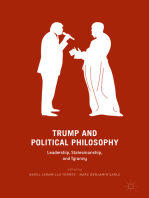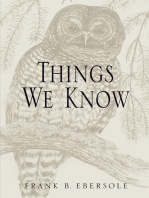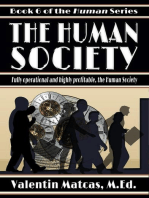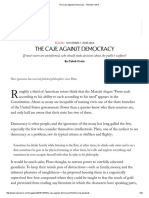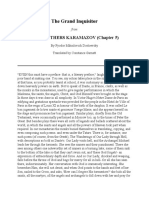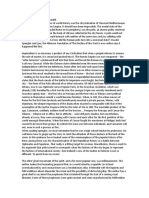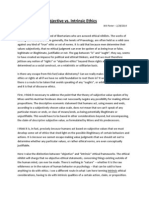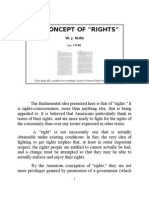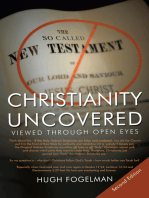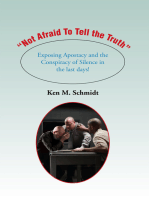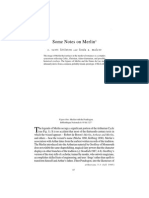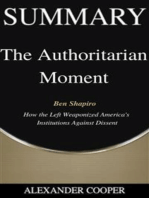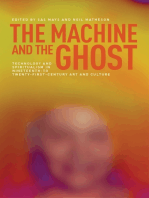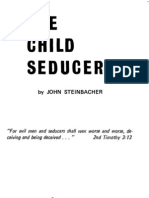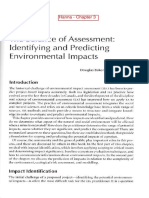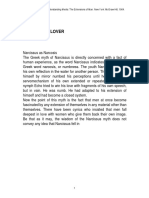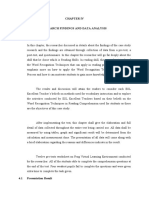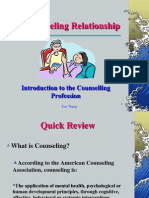McGinn's Ethics, Evil, and Fiction
McGinn's Ethics, Evil, and Fiction
Uploaded by
Shweta MishraCopyright:
Available Formats
McGinn's Ethics, Evil, and Fiction
McGinn's Ethics, Evil, and Fiction
Uploaded by
Shweta MishraOriginal Description:
Original Title
Copyright
Available Formats
Share this document
Did you find this document useful?
Is this content inappropriate?
Copyright:
Available Formats
McGinn's Ethics, Evil, and Fiction
McGinn's Ethics, Evil, and Fiction
Uploaded by
Shweta MishraCopyright:
Available Formats
NOS 34:4 ~2000!
648656
Colin McGinn, Ethics, Evil, and Fiction
~Oxford: Clarendon Press, 1997!.
Nol Carroll
University of Wisconsin-Madison
Colin McGinns Ethics, Evil, and Fiction is a short book, but philosophically
dense. Ranging from metaphysics to morality, across ethics and aesthetics, and
containing substantial exercises in literary criticism, the book contains more ideas
and more provocative suggestions than many works three times its size. Because the book is so packed with diverse topics and because the treatment of
these topics is often brief, the reader must do a lot of work filling in the text,
supplying the connections that McGinn has left unstated. As a result, the book
provides a strenuous intellectual workout, demanding careful reading and even
numerous re-readings. But McGinn possesses a powerful philosophical imagination, so trying to keep up with him is always interesting.
Among the tasks that McGinn leaves to readers is the problem of discovering the unity of the bookhow do the chapters hang together with each other?
It took me several re-readings before its principles of organization dawned on
me. So perhaps the best place to begin this review is to sketch the architecture
of the bookor, at least, my interpretation of its architecture.
Both the Preface and the Introduction initiate a series of programmatic complaints about the shortfalls in contemporary moral philosophy. It is McGinns
contention that the aim of the moral philosopher is to do justice to the varieties of moral experiences, to the entire range of ethical life... . ~p. 2! But
McGinn alleges that contemporary moral philosophy has failed in this regard.
Given the rest of the book, one surmises that the place where McGinn thinks
contemporary ethics is most remiss is in the discussion of character, and the
moral psychology thereof. However, recalling the resurgence of virtue ethics
over the last two decades, it is not clear to me that McGinns is an altogether
fair assessment ~though this oversight on his part may in part be explained by
the fact that folks in virtue ethics also usually begin by talking about this lacunae in contemporary ethical theory, as if they were not part of the practice!.
2000 Blackwell Publishers Inc., 350 Main Street, Malden, MA 02148, USA,
and 108 Cowley Road, Oxford OX4 1JF, UK.
648
McGinns Ethics, Evil, and Fiction 649
A second, related blindspot in contemporary ethical theory, according to
McGinn, concerns not topics, but resources. Literary fiction, he argues, is a vast
reservoir of moral discourse, so it is strange that ethicists interested in moral
discourse spend almost no time examining it. Also, literary fiction grapples
with moral questions at length and, thus, may afford a source of moral insight
and knowledgeunfortunately, again, too often ignored by moral philosophy.
McGinn attempts to repair this shortfall by providing a number of close readings of fiction throughout the text, including two final chaptersone on Oscar
Wildes Picture of Dorian Gray and another on Mary Wollestonescraft Shelleys Frankensteinthat are designed to show what philosophers of ethics can
learn from fiction.
Since McGinn believes that one purpose of fiction is to present and to reveal character in such a way as to invite moral appraisal ~pp. 23!, his two
complaints against contemporary moral philosophy are related: contemporary
moral philosophy neither attends sufficiently to the issue of moral character and,
perhaps for that very reason, it neglects a painfully obvious informant concerning moral discourse, judgment, and knowledgenamely, literature. Contrariwise, McGinn himself tries to show how attention to literature can enrich our
understanding of the moral judgments we make about evilevil people, people of evil characterand virtuous ones.
Because McGinn is ultimately concerned with moral judgment and its capacity to yield knowledge, the first two chapters of his book are preoccupied
with meta-ethics. The first chapter, entitled Goodness, is primarily negativea
brisk assault on naturalistic and psychologistic tendencies in ethics, undertaken, it would appear, because McGinn suspects they invite relativism, a position McGinn summarily finds repugnant. The second chapter, Knowledge of
Goodness, continues the attack on naturalism, but eventually evolves McGinns
own positive conception of moral knowledge: it is a priori, analogous to mathematical knowledge. McGinn does not, it seems to me, adequately address the
question of how, if moral knowledge is a priori, there is so much disagreement
about it. Nevertheless, this chapter sets up a framework in which to situate what
followsthe discussion of the concepts of evil and goodness, especially in terms
of the way in which they are applicable to human character.
That is, the heart of McGinns book is dedicated to giving us knowledge about
evil and goodness. Thus, he feels that it is necessary to establish that we can
have objective knowledge about these things, and that evil and goodness are
real properties ontologically. The burden of the first two chapters of the book
is to ground these claims: first by showing what is wrong with the kinds of psychologistic theories that might undermine claims to objective moral knowledge; and second by offering a positive characterization of moral knowledge as
a priori and as obtainable through the sort of reflection McGinn mobilizes in
the ensuing two chapters. The meta-ethical prelude of the first two chapters,
then, serve as premises for the putative discovery of moral knowledge about
good and evil in the following chapters.
650
NOS
Chapter 4, The Evil Character, investigates the concept of evilthat is,
pure evil rather than the instrumental evil of a burglar who perpetrates harm in
order to serve some other end. Pure evil, on McGinns account, is an attribute
of those who derive pleasure from pain and pain from pleasure; it is a matter of
malice for its own sake, not as a means to achieving some other goal ~pp. 62
63!. This is an interesting discussion, however, it might profit by spending more
time differentiating the person of pure evil from the person who takes pleasure
in the exercise of genuine retributive justice.
The fourth chapter also contains a lengthy discussion of the moral psychology of evil, which, for my money, is the most fascinating part of the book.
Considering pure evil, McGinn speculates about the conditions that are likely
to give rise to the person of pure evil. His intriguing suggestion is that pure
evil frequently arises from a state of existential envy: the feeling that everyone
elses life is better than ones own, which leads one to take pleasure in their
pain and pain in their pleasure and motivates the desire to inflict pain on those
supposedly better off to the point that they may renounce their putatively better
lives. McGinn, less successfully, I think, also attempts to link his diagnosis of
the conditions that give rise to evil to the violence of popular culture ~but more
on that later!.
The fifth chapter, Beauty of Soul, is the most ambitious in the book,
and probably the most controversial ~which is saying a lot, since this book
abounds with controversy!. Here, McGinn advances what he calls the aesthetic
theory of virtue, according to which virtue coincides with beauty of soul
~personhood! and vice with ugliness of soul ~p. 93!. That is, goodness and
badness of character are allied to aesthetic qualities of the person ~p. 93!. The
nature of this alliance is supervenience; beauty, albeit inner beauty, supervenes on properties of the moral personality, such as justice. Consequently,
where a person has certain aesthetic properties, such as inner beauty, that is
necessary and sufficient for his possession of personal goodness, i.e., virtue
~p. 97!.
McGinns overall project is to give us moral knowledge. The fifth chapter
proposes an illumination of the nature and concept of goodness, specifically of
virtue. Virtue is beautiful in the aesthetic sense. Beauty itself delights; this is
why we are attracted to virtue. Its opposite, ugliness, repels, and this is why we
shun evil or vicious people. One motive for being moral, among others, is that
through virtue we increase our own beauty, and we all putatively have an interest in increasing our own beauty. Moreover, humans have a propensity toward mimicry; thus, by surrounding ourselves with beautiful environments,
McGinn suggests, moral education is enhanced by encouraging us and our children to match the beauty of our moral personhood with the beauty of our surroundings. The chapter also broaches many other engrossing topics, such as the
problem of moral narcissism, which McGinn explains is a vice because it distracts us from the proper object of morality, which is other-regarding, by being
excessively and obsessively self-regarding.
McGinns Ethics, Evil, and Fiction 651
Before concluding, McGinn rounds off the book with two chapter-length
discussions of novels, Wildes Dorian Gray and Shelleys Frankenstein. As I
understand the function of these chapters in the book, the one on Dorian Gray
is intended to explore further the aesthetic theory of virtue. The chapter on Frankenstein, I think, is meant to send us back to the chapter on evil, particularly
to the discussion of the conditions of genesis from which the evil character
~the evil person! emerges. McGinn emphasizes that Shelleys book teaches that
the plight of Frankensteins monster could befall anyone. But what surprised
me about this chapter was that McGinn did not make more of the relevance of
his notion of existential envy here, since arguably that is the source of the Frankenstein monsters evil.
As well, as interpretations of the relevant texts, these chapters are somewhat
disappointing, since they add little that is new to a literary understanding of these
classics. This is a perhaps predictable outcome, insofar as McGinn shows little
familiarity with other scholarship on these books. Thus, it is a bit of a letdown
to encounter these explications as the proof of McGinns recommended reorientation of moral philosophy toward literary criticism.
McGinn concludes by returning to the theme that moral philosophy would
profit by taking literary fiction more seriously than it presently does. Moral discourse, as exemplified by the Bible, can be divided into two sorts: moral directives and parables. Moral philosophers, by focusing so intently on directives,
pay scant attention to parables, of which literary fiction is a prime example. But,
McGinn argues, narrative plays a crucial, formative role in moral experience,
geared as it is to scrutiny of particularsparticular persons and particular situations. Moreover, highly detailed stories are more likely to elicit more consensus than universalized moral principles and, thereby, to be highly revealing
about our moral concepts. If for no other reason, this should be a compelling
reason for moral philosophers to consult literature more often than they do. Thus
McGinn concludes where he began.
McGinn has the idea that the parable form activates moral knowledge that
we already possess and thereby becomes a pretext for rediscovering moral knowledge. This fits nicely with his notion that moral knowledge is a priori, though
he does not deal with longstanding worries that the moral insights derived
from fiction have been rhetorically rigged by their authors and that fictions
provide no confirmation, internal to the text, of the putative moral knowledge
they elicit from readers. Thus, though people like me who already subscribe to
McGinns viewpoint are happy to cheer his conclusions, I suspect the skeptic
will find the argument incomplete.
Since the most radical thought in this altogether radical book is McGinns
defense of the aesthetic theory of virtue, I will devote most of my commentary
to it. The theory maintains that virtue correlates with beauty of soul and vice
with ugliness. McGinn believes this thesis is literally true. Why?
First, the thesis makes sense out of a great deal of ordinary moral discourse
which is characteristically charged aesthetically. We speak of virtuous people,
652
NOS
for example, as pure and stainless, whereas evil people are foul, rotten, slimy, repulsive, toxic, and so on. The best explanation of these linguistic tendencies is that deep down we believe the aesthetic theory of virtueit
is what governs attributions like these. Furthermore, the aesthetic theory of virtue explains certain prominent regularities in our artistic practices. Why, in religious paintings for example, are saints depicted as beautiful? Again, because
deep down we believe the aesthetic theory of virtue, and the best way to express the conviction that beautiful souls are beautiful is to portray them as perceptibly beautifuleven if beauty of soul and perceptible beauty are different
and not necessarily convergent. Moreover, though presently out of fashion, the
aesthetic theory of virtue was an article of faith among moral theorists from
Plato to Shaftesbury, and, as well, is presupposed in literary works like Dorian
Gray, whose readers find little difficulty in assimilating it.
These considerations, however, only support the hypothesis that there is an
enduring mythology of the aesthetic theory of virtue. They corroborate the fact
that people have believed it in the past and that the remnants of that belief live
on in our language and its vocabulary, and in our art. That that mythology once
gripped peoples imagination in no way argues in behalf of the truth of the aesthetic theory of virtue. As McGinn is well aware, stronger arguments are required for that. And, of course, he obliges.
Needless to say, when McGinn speaks of the beauty of the soul, he is not
speaking of perceptible beauty. It is inner beauty, beauty that supervenes on virtue. He argues that evidence for the aesthetic theory of virtue includes that we
would not say someone were good, unless they possessed some inward beauty
~inward beauty is a necessary condition for being virtuous!. But, if I understand the thesis, it seems strained. Beauty of soul, if there is such a thing, would,
I presume, be striking, as perceptible beauty is. It could be subtle, but once
detected, it would be arresting. But most people are probably on the whole
virtuousgoodyet they are not striking with respect to inner beauty. Inner
beauty, if you are disposed to talk this way, might be the property of saints. But
there are many ordinary virtuous people who do not radiate inner beauty. Thus,
if the intuition that no person can be good and have no beauty of soul is supposed to support the aesthetic theory of virtue, I am not convinced that it is up
to the task.
McGinn also maintains that the possession of inner beauty is sufficient for
attributing inner beauty to persons. Perhaps this is connected to his view that
there are not any terms that describe the soul aesthetically that are morally neutral. But that seems wrong. Does McGinn count elegance as an aesthetic property? If he does, can we not imagine an evil genius whose mind is so elegant in
its operation, even given the ugliness of the projects to which he puts it, that its
brilliance and elegance are not over-shadowedmaybe even to the point where
we might concede that, on balance, his soul ~his mind! is ~inwardly! arrestingly beautiful. But then beauty of soul is not sufficient for attributions of the
possession of virtue.
McGinns Ethics, Evil, and Fiction 653
I must admit that I am a little uncomfortable attempting to evaluate McGinns
speculations about correlations between virtue and the aesthetic beauty of the
soul, because I am not confident, and certainly not as confident as McGinn,
that I know how we go about detecting beauty of soul, or even how McGinn
thinks we do it. That makes it difficult to assess what appear to me to be his
analytical conjectures. This is a place where more concrete, perhaps even literary, exemplifications of the relevant form of judgment would have been
apposite.
Another problem with evaluating a number of McGinns claims is that, for
most of the text, McGinn is not very forthcoming about what counts as beauty,
often saying no more than that beauty is what through its presence delights and
attracts. But this seems to be too thin an account, since, once again, I think that
most of the people I meet are probably virtuous and good, but I take no special
delight in that. In fact, I rather expect people to be good and so, when they are
in the ordinary manner, I am not particularly delighted or attracted to them in
any way that is analogous to the way in which truly beautiful vistas in nature
thrill me. Maybe McGinn will say that I should find the ordinary virtue of plain
folk ~like, I hope, myself ! more arresting than I do. But I worry that this begs
the question.
At one point, McGinn suggests that the place where the virtuous soul makes
obvious contact with deeply entrenched notions of beauty concerns harmony.
The beautiful soul harmonizes its virtues, and harmony, he claims, is the central aesthetic notion. Thus, it should come as no surprise that we describe the
virtuous soul in aesthetic terminology. But this observation is too facile.
Beauty is not always harmonious: dissonance in music can be beautiful, and
beautiful tragedies are rent with disruption. Likewise, virtuous souls need not
be harmonious. Indeed, it may be the mark of a truly virtuous soul that it be
torn between tragic alternatives. Harmony is not a necessary condition for beauty
in either artworks or the soul. Thus, McGinns comments about harmony do not,
it seems to me, logically bolster the aesthetic theory of beauty.
There is also a stunning omission in McGinns discussion of beauty that requires comment. He never addresses the Kantian view that beauty is disinterested in the sense that judgments of beauty are categorically separate from
assessments of advantage, including morality. This view, one of the deepest in
the tradition, would appear to contradict directly the aesthetic theory of virtue.
So why does McGinn never mention it? I do not expect McGinn to concur with
Kant on this point; I do not accept Kants account myself. But it is perplexing
that McGinn does not even air his reservations about the most formidable theory
of beauty we have, especially since it appears to be logically at odds with his
own view.
Though for much of the text McGinn is thin, even exasperatingly so, on what
he means by beauty, in one section, he does offer a thicker, more substantial
picture of it, which he calls Nabokovs formula. For McGinn, beauty is what
delights the aesthetic faculties. So, what delights the aesthetic faculties?
654
NOS
Paraphrasing Nabokov, McGinn says: an object is beautiful if and only if it
affords aesthetic bliss and aesthetic bliss is a state of mind in which one is connected to other states of being in which art is the normwhere art involves
curiosity, tenderness, kindness, and ecstasy. The beautiful object is what disposes us to these other-worldly states of being. In a word, it puts us into contact with certain ideals. ~p. 110! Which ideals? Presumably curiosity, tenderness,
kindness, and ecstasy.
Here the connection between beauty and virtue, so often obscure in the text,
becomes more perspicuous. If beauty ~what causes aesthetic bliss! is that which
puts us in touch with tenderness and kindness, then it is clear how it is connected with virtue. But is Nabokovs formula an acceptable characterization of
beauty? I think few are likely to agree.
Surely there are all sorts of examples of beauty that do not put us in contact
with kindness, tenderness, curiosity, and ecstasy. For example, the simple ~comprehensible in a glance!, delicate, bejeweled designs on the face of the Taj Mahal.
There is no question of kindness, tenderness, or curiosity here, and, though these
designs afford pleasure, it is tranquilnothing like ecstasy. Moreover, things
other than beauty are frequently ~perhaps even more frequently than our commerce with beautiful things! the source of contact with ideals of kindness, tenderness, curiosity, and ecstasy: sermons, even lackluster ones ~kindness and
tenderness!, science ~curiosity!, and mind-altering substances ~ecstasy! are cases
in point.
So, it is far from clear that Nabokovs formula supplies a persuasive characterization of beauty. Thus, to the extent to which McGinn relies on it to
ground the connection between beauty and virtue, the correlation remains undemonstrated. Of course, where the ideals of tenderness and kindness ~though
not curiosity and ecstasy! are built into the idea of beauty, the connection between some virtue and some beauty is secured, but I suspect that most philosophers and ordinary speakers will wonder about the necessary relevance of
kindness and tenderness to beauty in the first place, and, as a result, are apt to
worry that McGinn is playing with a stacked deck. Furthermore, even if we
accepted Nabokovs formula with respect to beauty, there would still be the
question of how informative it could be about the beauty of the soul, since it
is a characterization of beauty in art, whereas beauty of soul is a different
phenomenon.
Throughout McGinns examination of beauty of soul, I found myself resisting the very terms of the discussion. Like many moderns of a thoroughly unPlatonic stripe, I tend to think of beauty as a perceptible property. Indeed, the
term aesthetics was originally coined in the eighteenth century to label a form
of sensuous cognition. Even the aesthetic dimension of literature was thought
of in terms of the perceptible things described by the poet. Thus, to the extent
that beauty-talk has its natural home in perceptibilia, I find it hard to get my
mind around the notion of a beautiful soul; it strikes my ear as a category
mistake.
McGinns Ethics, Evil, and Fiction 655
But McGinn is ready for guys like me, and he has two arguments against us.
The first, following Thomas Reid, is that no physical thing ~no perceptible thing!
is intrinsically beautiful, but is beautiful rather because it expresses a mental
act which is the original source of the beauty. Thus, beautiful things, like paintings, inherit their perceptible beauty from imperceptible mental acts. Consequently, there should be no problem in calling souls ~minds! beautiful. Secondly,
it is not true that beauty talk is only reserved for perceptible things. Mathematical proofs and chess solutions are frequently called beautiful, and these need
not be perceptible.
The first argument seems to have little to recommend it, since Reids expressivism must be misguided; beautiful things in nature, like the starry sky at
night, do not inherit their beauty from any mental acts. Moreover, the second
argument appears to me to be inconclusive. Mathematicians do call proofs beautiful, but there is a real question here about whether they are speaking metaphorically. McGinn is aware of this possible line of objection, but he seems to
me to dismiss it with an argument that is way too hasty.
He points out that with respect to many aesthetically evaluable items, perhaps like pieces of music, aesthetic predicates, say sadness, are applied as
literal descriptors of perceptible configurations, such as, for example, sound
configurations. Though such aesthetic descriptions may be metaphorical, they
need not be. They may be literal. And this is true. But it does not seem to dispel the anxiety that the mathematicians use of the term beautiful is not a metaphorical use of the literal aesthetic concepts of beauty that we antecedently
apply to artworks. McGinn, I feel, still owes us a much more developed account of why we cannot consign the application of aesthetic terms, like beauty,
to imperceptibilia, like theorems and souls, to the realm of metaphor, namely
metaphors derived from literal aesthetic attributions to artworks.
In addition to defending the aesthetic theory of virtue, McGinn elaborates
some consequences that he thinks it suggests. One is a kind of aesthetic environmentalism. Beautiful environments, notably beautiful cultural environments,
stimulate the cultivation of the beautiful soul ~beautiful personhood!, whereas
aesthetic pollution has a tendency to lead to moral pollution... ~pp. 120121!
The mechanism here is mimicry; humans have a tendency to imitate. Surrounded
by beauty, including beautiful music, beautiful architecture, and so on, one has
an inclination to imitate it, to internalize it so that one might become a more
beautiful soul ~p. 120!.
I find this conjecture pretty imponderable. Since beauty of the soul is distinct from the beauty of objects, why should beauty in the latter sense, even if
it is imitated ~however one imitates beautiful architecture!, be conducive to
beauty in the former sense? The two sorts of beauty are so utterly different.
Likewise, in his discussion of evil, McGinn suggests that the violence of popular culture, including not only films and rock music, but sports, may afford a
dangerous precondition for the gestation of evil souls. For evil takes pleasure
from pain, and popular media depictions of violence associate pleasure with it.
656
NOS
And yet, it is also important to note that popular media representations of
violence typically downplay the pain and suffering that the violence entails. They
keep it offstage. The hero blasts a row of villains, but then the film does not
dwell on the pain the bullets incur. The pleasure may be in the violence, but
not in the accompanying pain. That is why fans of violent war movies are often
disgusted when they encounter real battle, where pain is everywhere evident.
Thus, I question whether in fact violent media are as potentially dangerous in
the formation of evil characterspeople who relish the pain of others for its
own sakeas McGinn does. McGinns fears about the corrupting power of violent media are as unwarrantedly pessimistic, it seems to me, as his predictions
about the redemptive power of aesthetically beautiful environments are overly
optimistic.
If I have found much to criticize in Ethics, Evil, and Fiction, it should also
be apparent that I found it an immensely engaging book. It is challenging, imaginative, and original, and, at every turn, it shows commanding philosophical sophistication. That it is now available in paperback is a boon. It would be an
ideal subject for advanced undergraduate and graduate seminars in either aesthetics, ethics, or the philosophy of literature. Or, as McGinn would argue, rightly
I think, in a single seminar on all three.
You might also like
- Emotionally Focused Therapy - ManualDocument37 pagesEmotionally Focused Therapy - ManualEdy-Claude Okalla Bana88% (8)
- Trump and Political Philosophy: Leadership, Statesmanship, and TyrannyFrom EverandTrump and Political Philosophy: Leadership, Statesmanship, and TyrannyAngel Jaramillo TorresNo ratings yet
- David Cole 1 2 3 4Document13 pagesDavid Cole 1 2 3 4microondesNo ratings yet
- Uterine Families and The Womens Community PDFDocument5 pagesUterine Families and The Womens Community PDFShweta MishraNo ratings yet
- Financial Behavior and Financial StressDocument17 pagesFinancial Behavior and Financial StressCharlize Mongado100% (4)
- Introduction To Applied Strategic PlanningDocument9 pagesIntroduction To Applied Strategic PlanningSaim Aym50% (2)
- Criminological Research 2Document3 pagesCriminological Research 2mark patalinghug100% (1)
- A Congress of The WorldDocument12 pagesA Congress of The WorldsudamailNo ratings yet
- Essay I by Nicolas Laos PDFDocument13 pagesEssay I by Nicolas Laos PDFYour Fellow LogicianNo ratings yet
- THE DARK SIDE OF Dialectics - Files PDFDocument32 pagesTHE DARK SIDE OF Dialectics - Files PDFJohn LiNo ratings yet
- Things We Know: Fifteen Essays on Problems of Knowledge: Second EditionFrom EverandThings We Know: Fifteen Essays on Problems of Knowledge: Second EditionNo ratings yet
- Angelic Organization Rev 3Document15 pagesAngelic Organization Rev 3elucipherNo ratings yet
- M.K. Gandhi, Attorney at Law: The Man before the MahatmaFrom EverandM.K. Gandhi, Attorney at Law: The Man before the MahatmaNo ratings yet
- Give Speech A Chance: Heretical Essays On What You Can't Say or Even ThinkFrom EverandGive Speech A Chance: Heretical Essays On What You Can't Say or Even ThinkNo ratings yet
- Voegelin On Hegel's SorceryDocument35 pagesVoegelin On Hegel's SorceryfonixaNo ratings yet
- White House Transcript of POTUS Call With Ukrainian President ZelenskyDocument5 pagesWhite House Transcript of POTUS Call With Ukrainian President ZelenskyThe Daily Caller80% (5)
- The Ultimate Justification of The Private Property EthicDocument11 pagesThe Ultimate Justification of The Private Property EthicBrent AncapNo ratings yet
- Return of Toynbee. European Union As UniDocument28 pagesReturn of Toynbee. European Union As UnimezbahNo ratings yet
- The Commonwealth of Nations by Lionel CurtisDocument779 pagesThe Commonwealth of Nations by Lionel CurtisormrNo ratings yet
- Superstition In All Ages (1732): Common SenseFrom EverandSuperstition In All Ages (1732): Common SenseNo ratings yet
- 60 Yrs of Human RelationsDocument17 pages60 Yrs of Human Relationstomor2No ratings yet
- Purification by AtheismDocument11 pagesPurification by AtheismakimelNo ratings yet
- Arena, The God Liber & Repub Notions of Libertas (2020)Document23 pagesArena, The God Liber & Repub Notions of Libertas (2020)Keith HurtNo ratings yet
- Was The Iraq War About The Dollar Vs The EuroDocument4 pagesWas The Iraq War About The Dollar Vs The Euroسید ہارون حیدر گیلانیNo ratings yet
- Constance CumbeyDocument4 pagesConstance CumbeyStephan WozniakNo ratings yet
- The Case Against Democracy - The New YorkerDocument9 pagesThe Case Against Democracy - The New Yorkersarwar sons100% (1)
- The Grand Inquisitor: The Brothers Karamazov (Chapter 5)Document16 pagesThe Grand Inquisitor: The Brothers Karamazov (Chapter 5)joeljuvinalNo ratings yet
- Operation Northwoods - U.S. Military Wanted To Provoke War With CubaDocument6 pagesOperation Northwoods - U.S. Military Wanted To Provoke War With CubaSalomeFaithNo ratings yet
- The Katechonic CommonwealthDocument3 pagesThe Katechonic CommonwealthHaruhi Suzumiya100% (1)
- Abuse in International TaxationDocument4 pagesAbuse in International TaxationAmarendraKumarNo ratings yet
- Objective Vs Intrinsic EthicsDocument8 pagesObjective Vs Intrinsic EthicsWill PorterNo ratings yet
- Bateson - 1935 - 199. Culture Contact and SchismogenesisDocument7 pagesBateson - 1935 - 199. Culture Contact and SchismogenesisChima Anyadike-DanesNo ratings yet
- The Collected Works of Earl of Beaconsfield Benjamin Disraeli: The Complete Works PergamonMediaFrom EverandThe Collected Works of Earl of Beaconsfield Benjamin Disraeli: The Complete Works PergamonMediaNo ratings yet
- Gnostic Mythos in Moby DickDocument7 pagesGnostic Mythos in Moby DickDaniel CorreaNo ratings yet
- Couliano Tree of GnosisDocument4 pagesCouliano Tree of GnosisedmontonguysNo ratings yet
- Paolo Sarpi and The DutchDocument29 pagesPaolo Sarpi and The DutchtitusgroanXXIINo ratings yet
- William James The Concept of RightsDocument10 pagesWilliam James The Concept of RightsMircea492003No ratings yet
- Nazi EcologyDocument5 pagesNazi EcologyBakcsi AlparNo ratings yet
- NASA The Future of WarDocument114 pagesNASA The Future of WarkingofswordsNo ratings yet
- “Not Afraid to Tell the Truth”: Exposing Apostasy and the Conspiracy of Silence in the Last Days!From Everand“Not Afraid to Tell the Truth”: Exposing Apostasy and the Conspiracy of Silence in the Last Days!No ratings yet
- Article, Nietzsche and The Great WarDocument14 pagesArticle, Nietzsche and The Great WarManu MartinNo ratings yet
- Port Huron Statement ExcerptDocument5 pagesPort Huron Statement ExcerptAlexia DunnonNo ratings yet
- The Anatomy of Philosophical Style PDFDocument276 pagesThe Anatomy of Philosophical Style PDFLance KirbyNo ratings yet
- The Philosopher and The Pale CriminalDocument7 pagesThe Philosopher and The Pale CriminalJames MichaelNo ratings yet
- Some Notes On Merlin - C. Scott Littleton and Linda A. MalcorDocument9 pagesSome Notes On Merlin - C. Scott Littleton and Linda A. MalcorMetasepiaNo ratings yet
- Summary of The Authoritarian Moment: by Ben Shapiro - How the Left Weaponized America's Institutions Against Dissent - A Comprehensive SummaryFrom EverandSummary of The Authoritarian Moment: by Ben Shapiro - How the Left Weaponized America's Institutions Against Dissent - A Comprehensive SummaryNo ratings yet
- The machine and the ghost: Technology and spiritualism in nineteenth- to twenty-first-century art and cultureFrom EverandThe machine and the ghost: Technology and spiritualism in nineteenth- to twenty-first-century art and cultureNo ratings yet
- Natural Law in the Spiritual World & Love, the Greatest Thing in the WorldFrom EverandNatural Law in the Spiritual World & Love, the Greatest Thing in the WorldNo ratings yet
- Psycho PoliticsDocument12 pagesPsycho PoliticsEd E. MuhibNo ratings yet
- ArmilusDocument6 pagesArmilusDaniel TheveninNo ratings yet
- DrugsDocument6 pagesDrugsPeter HermannNo ratings yet
- The Child SeducersDocument422 pagesThe Child SeducersurgesfromhellNo ratings yet
- Hutchinson-Gilford Progeria Syndrome: by Katie ZavackiDocument11 pagesHutchinson-Gilford Progeria Syndrome: by Katie ZavackiShweta MishraNo ratings yet
- Glossary of Film TermsDocument10 pagesGlossary of Film TermsShweta MishraNo ratings yet
- Hanna Chapter 3 3133 2Document21 pagesHanna Chapter 3 3133 2Shweta MishraNo ratings yet
- This Way To The GasDocument4 pagesThis Way To The GasShweta MishraNo ratings yet
- 7 - The Ouestion OF SignificanceDocument5 pages7 - The Ouestion OF SignificanceShweta MishraNo ratings yet
- Ethics in NursingDocument6 pagesEthics in NursingShweta MishraNo ratings yet
- Sonny's BluesDocument5 pagesSonny's BluesShweta MishraNo ratings yet
- History and AnthropologyDocument4 pagesHistory and AnthropologyShweta MishraNo ratings yet
- Management For The EntreDocument8 pagesManagement For The EntreShweta MishraNo ratings yet
- McLuhan The Gadget LoverDocument8 pagesMcLuhan The Gadget LoverShweta MishraNo ratings yet
- From+top+management+to+entreneurship+-+women 'S+next+moveDocument19 pagesFrom+top+management+to+entreneurship+-+women 'S+next+moveShweta MishraNo ratings yet
- Hurrell ArticleDocument29 pagesHurrell ArticleShweta MishraNo ratings yet
- The Ascent of ManDocument1 pageThe Ascent of ManShweta MishraNo ratings yet
- Wiley, Oxford University Press, The International Studies Association Mershon International Studies ReviewDocument27 pagesWiley, Oxford University Press, The International Studies Association Mershon International Studies ReviewShweta MishraNo ratings yet
- Amy McNair Donors of Longmen Ch6Document12 pagesAmy McNair Donors of Longmen Ch6Shweta MishraNo ratings yet
- The Adolescent Brain: New Research and Implications For Young People Transitioning From Foster CareDocument56 pagesThe Adolescent Brain: New Research and Implications For Young People Transitioning From Foster CareThe Vancouver Sun100% (1)
- 5 Reasons Why He DisappearsDocument13 pages5 Reasons Why He Disappearskarolina bochnakNo ratings yet
- Values and Professional EthicsDocument4 pagesValues and Professional EthicsJonyel De LeonNo ratings yet
- Teaching Across Proficiency LevelsDocument2 pagesTeaching Across Proficiency LevelsPaula HernándezNo ratings yet
- Republic of The Philippines Davao Oriental State College of Science and Technology Institute of Education and Teacher TrainingDocument1 pageRepublic of The Philippines Davao Oriental State College of Science and Technology Institute of Education and Teacher TrainingJaysonNo ratings yet
- What The CEO Really Wants From YouDocument8 pagesWhat The CEO Really Wants From YouVisweswara ReddyNo ratings yet
- Formation of Word Association TestDocument7 pagesFormation of Word Association TestAbie TablateNo ratings yet
- Report Arts ScriptDocument2 pagesReport Arts ScriptNeils MicNo ratings yet
- Syllabus HP 17Document3 pagesSyllabus HP 17Sheila Bernales-BoniNo ratings yet
- CHAPTER IV KamalDocument19 pagesCHAPTER IV KamalABNo ratings yet
- Studying Abroad - Is It Worth It?: DiscussionDocument5 pagesStudying Abroad - Is It Worth It?: DiscussionAryaNo ratings yet
- Session # 5Document2 pagesSession # 5J tanieeNo ratings yet
- Counseling PrinciplesDocument52 pagesCounseling Principleslehsem20006985100% (2)
- Indicator ChecklistDocument1 pageIndicator ChecklistemmanuelNo ratings yet
- Job InterviewDocument26 pagesJob InterviewRuri McmillianNo ratings yet
- 3 Principle of Body PhysicsDocument5 pages3 Principle of Body PhysicsAdrian Francis A. UyNo ratings yet
- Stress Free Living - PpsDocument38 pagesStress Free Living - Ppsnandini bubNo ratings yet
- Talisayon Chapter 4 DepEdDocument13 pagesTalisayon Chapter 4 DepEdShekaina Faith Cuizon LozadaNo ratings yet
- Research HXKSDDocument4 pagesResearch HXKSDEarl Cris Riggs100% (1)
- #PREP Leadership Principles at AmazonDocument2 pages#PREP Leadership Principles at AmazonDmitry KurbakovNo ratings yet
- Vondette Quack Quack Title and PatternDocument8 pagesVondette Quack Quack Title and Patternapi-278009574No ratings yet
- Acfrogaub Pqcr8k7jl8qxmqwb6hx1wkydugizspikxd256kmxc5yshnt9j0wtxoazxd9lzbrvtrm8xysawxo 1bmayczy9jzt Uoidannhmxigmmc1p9nzybwuyze9ce7lpedsmnfrvfefe XirDocument5 pagesAcfrogaub Pqcr8k7jl8qxmqwb6hx1wkydugizspikxd256kmxc5yshnt9j0wtxoazxd9lzbrvtrm8xysawxo 1bmayczy9jzt Uoidannhmxigmmc1p9nzybwuyze9ce7lpedsmnfrvfefe XirAlmira COMIANo ratings yet
- PR 1 - QTR 3 - Week 2Document8 pagesPR 1 - QTR 3 - Week 2Angela Ellijah MelendezNo ratings yet
- QUESTIONNAIREDocument3 pagesQUESTIONNAIREnashra janNo ratings yet
- (Essential Psychology) Stephen Walker - Learning and Reinforcement-Methuen (1975)Document110 pages(Essential Psychology) Stephen Walker - Learning and Reinforcement-Methuen (1975)Víctor FuentesNo ratings yet
- Online TESOL - Online TEFL ITTT Answers - Unit 1Document4 pagesOnline TESOL - Online TEFL ITTT Answers - Unit 1helina.kasturiNo ratings yet

